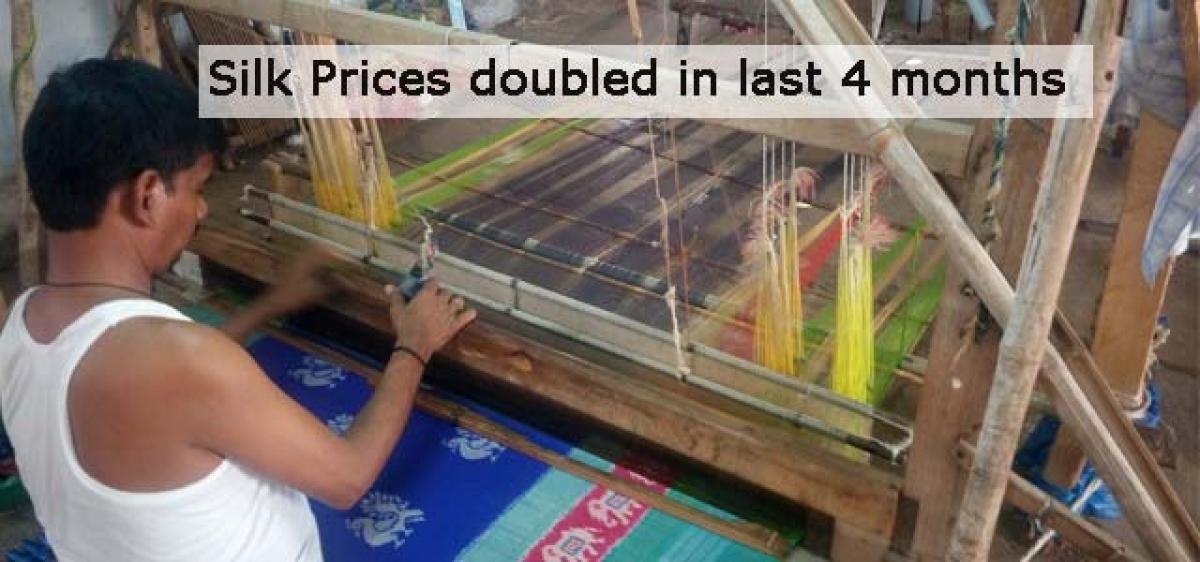Live
- AI can boost early diagnosis of liver disease: Study
- Varun's appointment as AHUDA chief infused new vigour in JSP cadres
- Lokayukta, HRC will remain in Kurnool: Minister Bharath
- S Korea, US, Japan unveil secretariat establishment, slam N Korea-Russia on Ukraine war expansion
- Light to Moderate Rains Expected in Telangana and Andhra Pradesh
- Pilgrims throng Sabarimala temple on opening day of long festive season
- Jwala Thoranam held at Srisailam temple
- Birsa Munda Jayanti celebrated
- Another tigress released in soft enclosure in Similipal
- Coastal defence exercise on Nov 20-21
Just In

Even as the central government painted a rosy picture about the country\'s economy during the disruptive demonetization period that began in November 2016, the weavers of renowned Pochampally saris are still reeling under the aftershocks of the currency ban, with the prices of silk yarn skyrocketing in the last few months.
Bhoodan Pochampally (Yadadri Bhongir district): Even as the central government painted a rosy picture about the country's economy during the disruptive demonetization period that began in November 2016, the weavers of renowned Pochampally saris are still reeling under the aftershocks of the currency ban, with the prices of silk yarn skyrocketing in the last few months.
The main raw material for the weavers in this part of the world, silk yarn was available for around Rs 3,000 a kilogram before the Modi government announced its note ban exercise in early November.
The price has zoomed to Rs 3,800 a kg by the time the exercise ended in December and is now hovering at around Rs 4,500 a kg, a whopping 50 per cent escalation in the last four months.
"We were making decent earnings till November. Everything went awry after the note ban. We are in a soup now as yarn prices have escalated beyond imagination while prices of saris and other woven materials remained stagnant", Joshikallu Shiva Kumar, a young dyeing artist, told The Hans India even as he carefully applied red dye on a bunch of silk yarn at a tiled-house in this sleepy village.
Kumar, schooled till fifth class, lamented about lack of remunerative prices for weaving community while four skilled weavers were busy at their respective handlooms in the same house, creating next batch of famous Pochampally Ikat saris. "It takes at least five days to weave a sari as we have to meticulously work on each thread, dye it and weave it. What we get in return for our hard work is miniscule now,” he rues.
Local traders, mostly belonging to weavers’ community, were also equally impacted. “We either procure directly from the weavers or get saris weaved by supplying yarn to them. The abnormal rise in yarn prices has adversely impacted our business because we are not in a position to increase prices of saris as such a move will lead to drastic fall in sales, thereby affecting weavers,” said Boga Markandeya, owner of Sri Bhuvaneshwari Handlooms, a sales outlet in the village. He sources saris and other handloom material from 50 local weavers.
There are around 8,000 handlooms in Pochampally and surrounding villages. The weavers source silk yarn mainly from Bengaluru while dyes are brought in from Mumbai. “We supply nearly 400 kg of silk yarn to weavers every month. The steep rise in prices is said to be on account of yarn scarcity as silk farmers failed to get good harvest due to the note ban.
We don’t know how long these high prices will last, but they have taken a toll on weavers,” said Bharatha Vasudev, president, Pochampally Handloom Weavers’ Co-operative Society. But the economic data announced by the Central Statistics Office (CSO) on Tuesday painted a different picture and said GDP grew 7 per cent during October-December, 2016, despite the note ban.
Though the central government offers a 10 per cent subsidy on silk yarn bought by weavers, the scheme is applicable to only those who have been registered with the central government. Given the prevalent red-tape and lackadaisical attitude of the government agencies, both at the Centre and in the State, that administer the schemes for weavers, it's anybody's guess how beneficial and effective such schemes are.

© 2024 Hyderabad Media House Limited/The Hans India. All rights reserved. Powered by hocalwire.com







